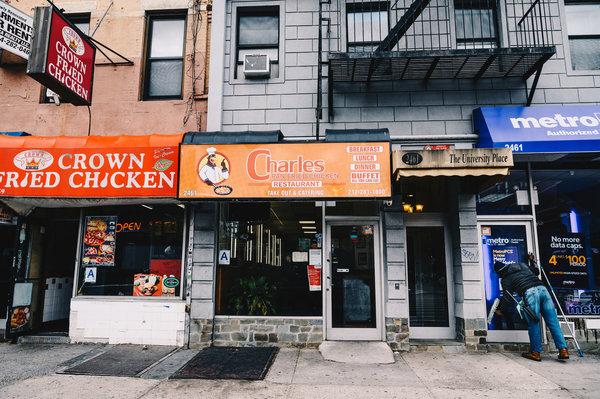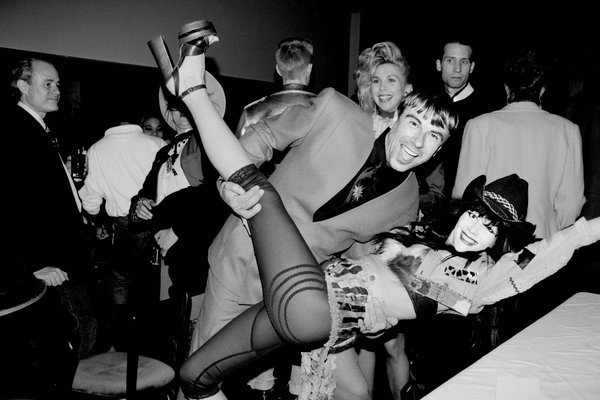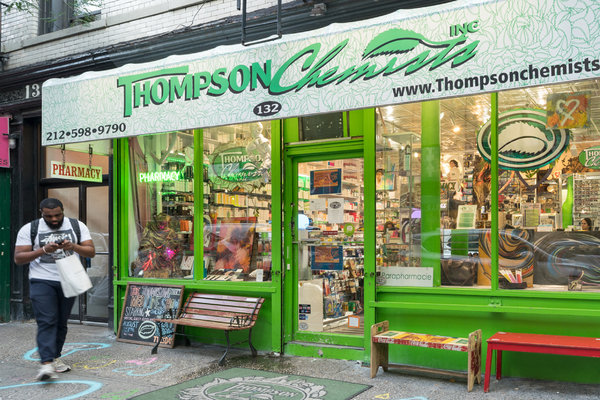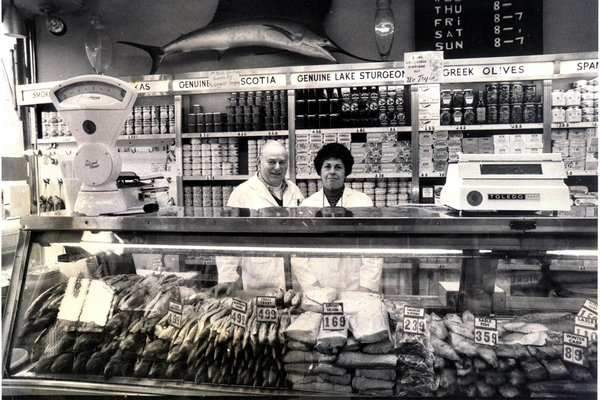In this series for T, the author Reggie Nadelson revisits New York institutions that have defined cool for decades, from time-honored restaurants to unsung dives.
A February night in Harlem, 7 in the evening, and at Charles’ Country Pan Fried Chicken, a faint aroma wafts out on the cold night air. At 132nd Street and Frederick Douglass Boulevard, Charles’ is a storefront restaurant; nothing fancy, it’s jammed in the middle of a block and has an orange awning featuring a chicken dressed up as a chef. Inside the long narrow room, the fluorescent lighting does not flatter, and there are only seats for about 15 or so, but who cares? You’ve come for the fried chicken.
It’s a busy night. Charles Gabriel, chef and owner, is still downstairs in the kitchen frying up chicken pieces in one of the dozen black cast-iron skillets he prizes, sending up fresh batches one at a time. There are historians who claim that fried chicken came from Scotland first. But for most Harlemites it came from the South and some of the best by way of Charles Gabriel, who’s been cooking it up for decades, first from a food truck, then at a restaurant on 151st Street and now at the current location. Nostalgia can be a sweet poison, but old traditions like Charles’ make New York worth living in.

Charles’ Country Pan Fried Chicken at 2461 Frederick Douglass Boulevard, photographed in February 2019.CreditNina Westervelt
This is the Platonic ideal of fried chicken, the essence of a bird, moist, tender, mouthwatering in its crispy delicately seasoned crust, every batch seasoned three times, constantly turned, gently pan-fried in soybean oil, low in saturated fat — in case you’ve been reading health columns that say fried chicken can kill you; anyhow, this is chicken I’d die for. Apparently so would regulars Whoopi Goldberg, Danny Glover and Wesley Snipes. On the most recent Super Bowl Sunday, Charles sold 2,000 pieces of chicken.
Coming up from the kitchen with freshly fried chicken, Charles greets an older woman by name, kisses a little girl in a pink winter jacket. “Harlem has a lot of love for Charles,” says Karen Murray, a friend and occasional eating pal who is otherwise a singer and voice-over actor. With her husband Curtis Archer, she’s come to meet me for dinner. The little girl in pink announces that she “loves the chicken.” She knows what she’s talking about. In 2018, Charles was a semifinalist in the James Beard Awards.
“The chicken is seasoned to perfection, a component often missing in fried chicken,” says Karen, as we consider our first pieces with lust. To tell the truth, she and I have both been on no-carb diets since New Year’s, but one bite of the chicken and we’re both lost to it. The skin, as it slides off, has a lovely crunch; the juicy flesh gives way in your mouth. People still waiting in line eye us enviously. You get a couple of sides with your chicken: Karen’s working on mac and cheese, I have yams, and there’s okra, collard greens, black-eyed peas, white rice. Charles serves smothered pork chops, oxtail and barbecue, but most people go for the chicken.
“Just a buttermilk-and-egg wash overnight,” says Charles. “Dip it in A.P. flour, salt and pepper, then a few secret extras,” he adds, with a faint smile. While he’s frying the chicken, he turns it over and over and seasons it three times. “That’s all,” he says, as if anyone could do it, but no one else has invested a lifetime of history, passion, bad times and good in making it perfect.
Born in rural North Carolina, one of 21 kids, Charles learned to cook from his mother. His own two sons live in the South now and both cook. I ask him if he might go back. “I have memories,” he says plainly. “We lived on a plantation. My parents were sharecroppers. When I was 6 or 7, I got up at dawn to go to the cotton fields and help with the picking.” He walked four or five miles to school and by 12 he was milking cows. At 20, he followed his brother to New York and he arrived in the middle of the 1965 blackout.
“I was always cooking,” he says. “Before I had a restaurant, I had a table in the park, then I had a food truck.” His original restaurant on 151st Street was a gathering place; people often tell Charles they ate there as kids. Rising rents and a bad landlord forced him out. He struggled to survive.
“The new Harlem food landscape has been changing since around 2000 when new eateries started opening and the historic landmarks started to shutter,” says Curtis, who works for the Harlem Development Corporation. “Harlem was the black capital and had a lot of people from the South. After a long night of partying, friends would all gather to break bread, often at soul food restaurants. This was comfort food,” he says. With all the new apartment buildings going up, fancy restaurants opening and millennials swooping in for the neighborhood’s cool, things have changed for Charles as well. “A lot of young people now want to grab and go,” he says. The sides he cooks are now all vegetarian, a concession to some of the new young Harlem crowd.
As it gets late, Charles and Curtis shoot the breeze about the Harlem they knew once, the people they knew, the places they ate. Wilson’s, Copeland’s, Flash Inn; all gone, Curtis says. “It wasn’t just about food but community,” says Curtis. The talk invests the meal with a sense of loss and survival. But, then, this is New York. This is Harlem.
For dessert, there’s the homemade peach cobbler and rich banana pudding — Charles makes his own custard. Karen, like me, when it comes to that diet, has now completely fallen. With a sigh, she puts down her spoon and says, “It’d be great to see Charles’s business expand,” adding, “I don’t believe the quality would ever suffer. As mild-mannered as he is, I can’t see Charles tolerating that for one second!”







